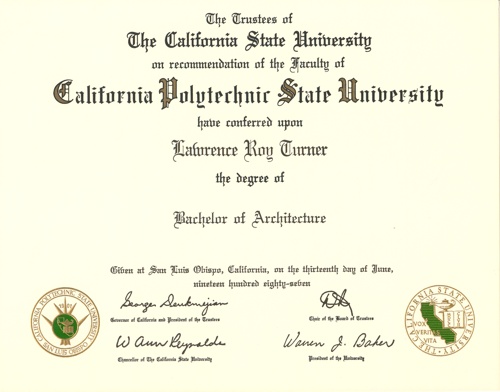
Post-professional degrees are not required nor are they NAAB-accredited. Examples of these areas are ecology, urban studies, and applied research.
#Architect degree professional#
You can enroll in post-professional masters or doctoral degree programs for highly specialized study in areas not covered in professional programs. While actual coursework varies by school, professional architecture coursework may include the following:Īfter you complete your professional program and perhaps get some experience as well, you may decide to take your education even further.
#Architect degree plus#
This type of program is commonly referred to as a four-plus-two program (four years to earn a bachelor's degree plus two years to get an M.Arch.). Since you already have taken some of the basic coursework in college, you will earn your M.Arch. programs to get your professional education. For Students With a Pre-Professional Bachelor's Degree: If you have a pre-professional degree, for example, a Bachelor of Science (B.S.) or Bachelor of Arts (B.A.), in architecture or architectural history, you can apply to M.Arch. Since you haven't already taken courses in this discipline, it will take about three to four years to complete your degree.

You can instead earn a Master's degree in Architecture. For Students With a Non-Architecture Bachelor's Degree: If you have an undergraduate degree in another subject, you don't have to get a bachelor's degree in architecture. In addition to taking classes to fulfill general education or core requirements, for example, math, social science, science, and humanities, you will take classes in architecture. Students who have studied for five years at an accredited architectural school are awarded this degree.

B.Arch.: If you don't have a bachelor's degree yet, you can go to college to earn a Bachelor of Architecture degree.Which one you need depends on your educational background.

These professional degrees include the Bachelor of Architecture (B.Arch.) and Master of Architecture (M.Arch.) degrees. To work as an architect almost anywhere in the United States, you will have to earn a professional degree from a program that has received accreditation from the National Architectural Accrediting Board (NAAB). In addition, you should also take trigonometry, geometry, and physics courses. If you are still in high school and aspire to study architecture in college, it is a good idea to take at least a couple of semesters of studio art classes before you graduate. While architects aren't expected to be fine artists, they should have some background in design. Ask yourself the following questions: Are you creative? Do you easily understand what others say to you? Can you find alternative solutions to problems, evaluate them, and then implement the most appropriate one? Good listening, problem solving, and critical thinking skills are imperative.īefore you move ahead with your education, honestly assess whether you possess these traits. You must also have the ability to visualize how a structure will look once it is built or after changes are made to it.

It will allow you to come up with new ideas. You will acquire all the technical skills you need to work in this field through your education and training, but without certain characteristics, called soft skills, it will be almost impossible to succeed. In designing structures, they must also be attentive to the needs of the people who will use them and the projects' budgets. While a great deal of their focus is on the way buildings and other structures look, they are just as concerned with their function and safety. We often think of architects as artists, but they are so much more.


 0 kommentar(er)
0 kommentar(er)
